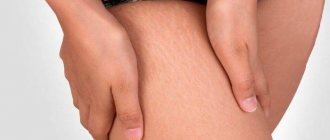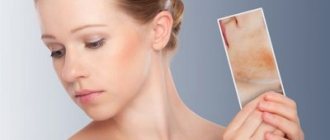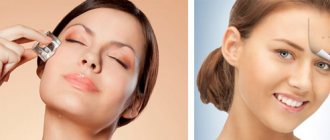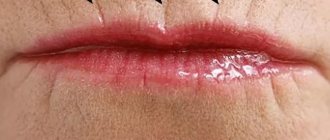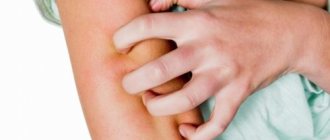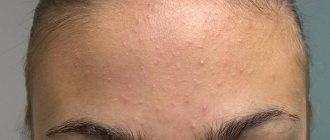Pregnancy is the most exciting and touching state in a woman’s life. But along with the joys of new discoveries and the expectation of a miracle, specific problems arise. Specifically, skin changes such as stretch marks. You need to take care of yourself in advance so that after giving birth you still feel attractive. We will tell you what causes stretch marks and what you can do during pregnancy and after childbirth.
Stretch marks (striae) are internal scars of the skin, they arise due to stretching of the skin, the upper layer of skin (epithelium) does not keep up with the growth of the abdomen, elastin fibers are torn and replaced by scar tissue. It is difficult to predict the appearance and type of stretch marks.
The skin consists of three layers: the epidermis (the upper, constantly renewed layer), the dermis (a dense connective tissue frame, a kind of “mesh” that provides firmness and elasticity of the skin) - stretch marks appear in it, subcutaneous fatty tissue (adipose tissue, expressed in all to varying degrees).
Is it possible to avoid stretch marks during pregnancy?
The mechanism of formation of striae is associated with degradation and subsequent atrophy of dermal tissue fibers. Avoiding the appearance of stretch marks is not easy, especially there are objective reasons: multiple pregnancy, polyhydramnios, the age of the expectant mother, heredity.
But some factors, such as hormonal imbalance and decreased turgor, can be corrected. If you cannot completely avoid a cosmetic defect, you will be able to reduce its severity.
Stretch marks and the period of their appearance
During pregnancy, as the baby's weight increases, the expectant mother's belly grows. At this time, many women begin to notice stretch marks in problem areas: on the stomach, buttocks, chest, hips.
The appearance of stretch marks is explained by strong tension of the skin, resulting in rupture of tissue structures. The damaged area is overgrown with connective tissue, resulting in the formation of stripes resembling scars.
Newly appeared stretch marks are pink in color because they are riddled with blood vessels. Over time, the stretch marks become lighter and stop responding to sun exposure. Therefore, even with intense ultraviolet radiation, stretch marks will remain light.
The timing of the appearance of ugly scars is individual for each woman. It is impossible to name a specific period. Some women notice stretch marks already in the first trimester of pregnancy, while others do not find them at all.
The formation of grooves depends on the woman’s skin type. Given this, it is necessary to care for the skin throughout the entire period of pregnancy.
How to avoid stretch marks during pregnancy
There are no effective means and methods that can help 100% prevent the appearance of a cosmetic defect. Stretch marks occur as a result of loss of skin elasticity. Compliance with a number of preventive measures helps maintain skin tone and, accordingly, reduces the likelihood of the formation of linear stripes on different parts of the body.
Nutritional adjustments for stretch marks during pregnancy
Pregnant women should strictly monitor their weight. Extra pounds negatively affect your overall well-being and are one of the reasons for the appearance of stretch marks.
To prevent the formation of stretch marks, it is not necessary to adhere to any special diet, but it is still necessary to follow a number of nutritional rules:
- Focus on fruits and vegetables. These colorful foods are rich in vitamins A and C, which improve the condition of the epidermis. Vitamin C affects the rate of collagen formation.
- Give preference to lean proteins. Chicken, fish, quail eggs, and nuts contain various amino acids with a structure similar to collagen. Eating lean protein will increase the elasticity of the dermis.
- Maintain your water balance - drink enough liquid. Linear stripes often appear on dry dermis. To prevent edema, it is recommended to drink green tea.
Be sure to read:
Stretch marks in men: reasons, how to get rid of them, the best drugs and folk remedies
Women should limit their consumption of sweets and starchy foods. These products are the main “provocateurs” of weight gain.
Cosmetics and natural products
Many expectant mothers use ready-made and homemade cosmetics to prevent scars. Among store-bought products, the most popular are natural-based creams and gels.
| Name | compound | average cost in rubles |
| Mama Comfort | vitamins A, E, tea tree oil, olives, castor, hyauuronic acid | 250 |
| Baby Line | glycerin, tocopherol (vitamin E), beeswax | 350 |
| Sanoson | hibiscus seed extract, chitosan, milk proteins | 500 |
| Mustela | shea butter, avocado, sunflower, amino acids | 1400 |
| Doctor Babor | macadamia nut, avocado, retinol, polypeptides | 7400 |
You can also prevent scarring with home remedies:
- Cream. Mix 2 tbsp. l. fat sour cream, tbsp. l. lemon zest and 10 drops of olive oil. The resulting composition is rubbed into places where breaks in the epidermal fibers most often occur: the lower abdomen, chest, buttocks.
- Scrub. Ground coffee is mixed with sour cream in equal parts. The mixture is applied to the abdomen, chest, and thighs.
Home peeling procedures are carried out no more than 3-4 times a week.
Cold and hot shower
A contrast shower is a physiotherapy procedure. It has immunostimulating, vasodilating effects and is safe during pregnancy. Alternating warm and cool jets improves blood circulation and trophism of the skin.
The procedure ensures faster delivery of oxygen and nutrients to the epidermal cells. Regeneration processes are activated, the dermis acquires elasticity. Water under pressure triggers metabolic reactions.
After a shower, it is recommended to moisturize the dermis. Freshly squeezed aloe juice should be applied to the skin.
Bandage and prenatal bra for stretch marks during pregnancy
Wearing supportive underwear – a bandage and a prenatal bra – is strongly recommended by obstetricians and gynecologists. A special elastic belt reduces the load not only on the back muscles, but also on the skin. It is advisable to buy a combined bandage. It is used starting from 22-24 weeks of the gestational period. Wearing after childbirth promotes rapid restoration of the figure and epidermis, reduces the likelihood of the appearance of linear stripes.
Be sure to read:
How to remove stretch marks at home: the best ways to get rid of them on the body
A prenatal bra performs a similar function - it reduces pressure on the breasts and prevents overstretching of the dermis. The support garment can be easily adjusted to suit your breast growth rate. Natural fibers ensure normal skin breathing.
Light physical activity – prevention of stretch marks
Light physical activity is indicated for most expectant mothers. They help improve blood circulation and prevent the development of varicose veins and stretch marks. Types of exercises during the gestational period are selected individually and only after consultation with a doctor.
The following types of physical activity are recommended for expectant mothers:
- Yoga is a set of exercises that helps relieve psychological stress. Smooth loads improve muscle condition, firmness and elasticity of the skin.
- Charger . Light physical exercise prevents excess weight gain and overstretching of the epidermal fibers.
- Walking improves well-being and breathing, including cellular breathing.
Physical exercises should be started as early as possible.
Treatment of stretch marks after childbirth
When the baby has already appeared, the lactation period has begun, there is no need to stop skin care. Nourishing, moisturizing creams are also used, but only with the composition approved for breastfeeding. Massages, wraps, baths, scrubs - all this has a positive effect on the skin of the feet. Don't forget about proper nutrition, which is also important during lactation.
When you finish breastfeeding, you can try modern methods of aesthetic surgery. This is advisable for deep or extensive lesions, when stretch marks are really noticeable on the legs.
Common procedures for getting rid of stretch marks include the following:
- Laser exposure. Aimed at improving the regenerative reactions of tissues, which allows eliminating dermal defects in a short time.
- Microcurrent therapy, carried out under the influence of low voltages.
- Injections of collagen, activators of metabolic reactions, mesotherapy.
- Chemical peeling.
- Microdermabrasion or a kind of polishing of the upper layers of the epidermis.
It is sometimes difficult to completely get rid of stretch marks during pregnancy if the body is weakened and the skin has not received special care. Therefore, expectant mothers already in the first trimester need to choose the most suitable cosmetic product, monitor not only their health, but also pay attention to the condition of their skin and nails.
Fresh stretch marks appeared on the stomach during pregnancy: what to do
If scar bands are detected, measures should be taken immediately to eliminate them. It is easier to get rid of fresh stretch marks than old ones.
Dermatovenerologists recommend using creams containing vitamins A, E and C, and collagen-elastin complex. Cosmetics begin to be used from 3-4 months of the gestational period. The means are selected taking into account the individual characteristics of the body.
Massage using oils helps a lot. Light stroking and pinching improve blood circulation, stimulate the synthesis of fibrillar protein, which is responsible for maintaining the structure of the dermis, oils provide sufficient hydration.
Signs of striae
When the upper layer of the epidermis is stretched and thinned, collagen fibers are torn. This is accompanied by itching; the woman often scratches such places.
Before stretch marks form, the skin turns pink, then the color of the formation changes: stretch marks can be pink, burgundy, purple, or brown. The stripes can also become convex. Over time, the grooves lighten and align with the level of the skin.
Occurrence zones
The most “favorite” places for stretch marks are the stomach, hips, chest, and buttocks. Scars on the thighs often form after childbirth. Striae in the chest area appear during lactation.
Very often, in women with navel piercings, the skin in this area stretches unaesthetically during pregnancy.
The grooves on the abdomen are considered the most problematic, as they quickly increase, becoming deep and bright. Getting rid of such stretch marks is not easy.
Stretch marks during pregnancy: how to get rid of old ones
It will not be possible to completely eliminate old stretch marks, but it is quite possible to reduce them. One of the effective methods of dealing with scars is salon procedures.
But most of them are contraindicated for expectant mothers, so it is better to use folk remedies:
- Mask . Raw medium-sized carrots are passed through a meat grinder, tsp added. lemon juice and baby cream to form a thick mass. The mixture is applied to areas with linear stripes for 20 minutes and washed off with warm water.
- Recipe with mumiyo. Combine 50 g of cream or Vaseline, 3-5 g of mumiyo, 20 ml of water, mix thoroughly. The resulting composition is applied to the affected areas for half an hour.
- Bodyaga helps fight purple stretch marks. The powder is diluted with water to a creamy consistency and rubbed onto the dermis. The treated areas are wrapped in cling film and washed off after 15 minutes.
Be sure to read:
How to remove stretch marks on the thighs: what causes stretch marks, the most effective ways to combat them
Home recipes are used after prior consultation with a doctor.
How do stretch marks appear in pregnant women?
Location of stretch marks according to frequency of occurrence: abdomen, breasts (breast enlargement during pregnancy and lactation is individual), hips and buttocks (physiological increase in fat layer is intended by nature for the normal exchange of female hormones, in particular estrogen, but weight gain is not always and not for everyone corresponds to the needs of the body), calves (stretch marks form here very rarely, mainly in women with severe swelling that cannot be treated for a long time).
Stretch marks can be pink, dark and light purple, or red in color and vary in width and length. From small narrow and light pink stripes in the lower abdomen or on the chest to wide dark purple stripes along the entire anterior abdominal wall and thighs. The critical period for the appearance of stretch marks on the abdomen and thighs is the third or fourth month of pregnancy, on the chest - the lactation period, on the legs - the postpartum period, when swelling decreases.
After childbirth, stretch marks gradually fade, become denser in texture and acquire a light silvery, white color. These changes do not completely disappear, but with proper care, skin tone is restored and stretch marks become less noticeable. Stretch marks do not tan because they are scar tissue and do not produce the pigment melanin.
Prevention
It is almost impossible to get rid of stretch marks that appear during pregnancy, so to reduce the risk of their formation, you need to take care of your skin in advance.
Physical activity and nutrition
The task of a woman carrying a child is to walk in the fresh air every day. It is useful to go to the pool, do pregnancy fitness, and exercise with a fitball. Minimal physical activity improves blood circulation, saturates the epidermis with oxygen, and tones the muscular system.
It is also important to eat right, enrich your diet with foods containing proteins and vitamins, which help improve the elasticity of the skin.
Massage
Doctors advise performing a circular massage using a contrast shower. You can also use a mitten made from natural materials for massage. The procedure will become more effective if you add natural oil.
Bandage and support garments
The second and third trimesters of pregnancy require a change of clothes and underwear. Women should purchase a prenatal bra, choosing a model made from natural fabrics, with wide straps and without wires. Panties should be cotton, not too tight; you can choose a model that fits on the hips.
Wearing a bandage is important. The device not only supports the fetus, promoting healthy gestation, but also prevents the skin from stretching. The bandage should be worn correctly, according to the instructions, since incorrect use can harm the child.
Salon treatments and wraps
Often, pregnant women resort to the services of beauty salons, which offer a variety of procedures that help moisturize and nourish the skin. For stretch marks, a wrap with seaweed and a bath with mineral salts will be effective.
If stretch marks cannot be avoided, then after childbirth you can resort to mesotherapy, chemical peeling, laser resurfacing, or abdominoplasty.
Masks and scrubs
Before any procedure on the epidermis, it is necessary to clean it with scrubs that remove the surface layer, activating the synthesis of collagen fibers. You can prepare a natural scrub yourself at home.
The peeling agent should not contain large particles, as they injure the skin.
The best scrub is made from ground coffee beans, to which you can add natural honey or vegetable oil. This peeling effectively cleanses the skin, preparing it for applying the mask.
As a mask, you can use a mixture of green, red and blue clay. The resulting product should be applied to problem areas and wrapped with gauze. Also effective are honey masks that nourish the skin, restoring the affected areas.
Oils
Oils have been successfully used in the fight against stretch marks. There are three groups of oils.
- Vegetable: olive, apricot, sea buckthorn, almond, coconut.
- Essential: grape seed, jojoba, rosewood, sandalwood, orange.
- Cosmetic: Johnson's baby, Weleda.
Daily rubbing of any oil will help renew, tone and moisturize the epidermis.
Lotions
Pharmacies and specialty stores sell many lotions that prevent scarring. The most popular include:
- Phytolastil;
- Mederma;
- Contractubex.
Before using the product, you should consult your doctor.


